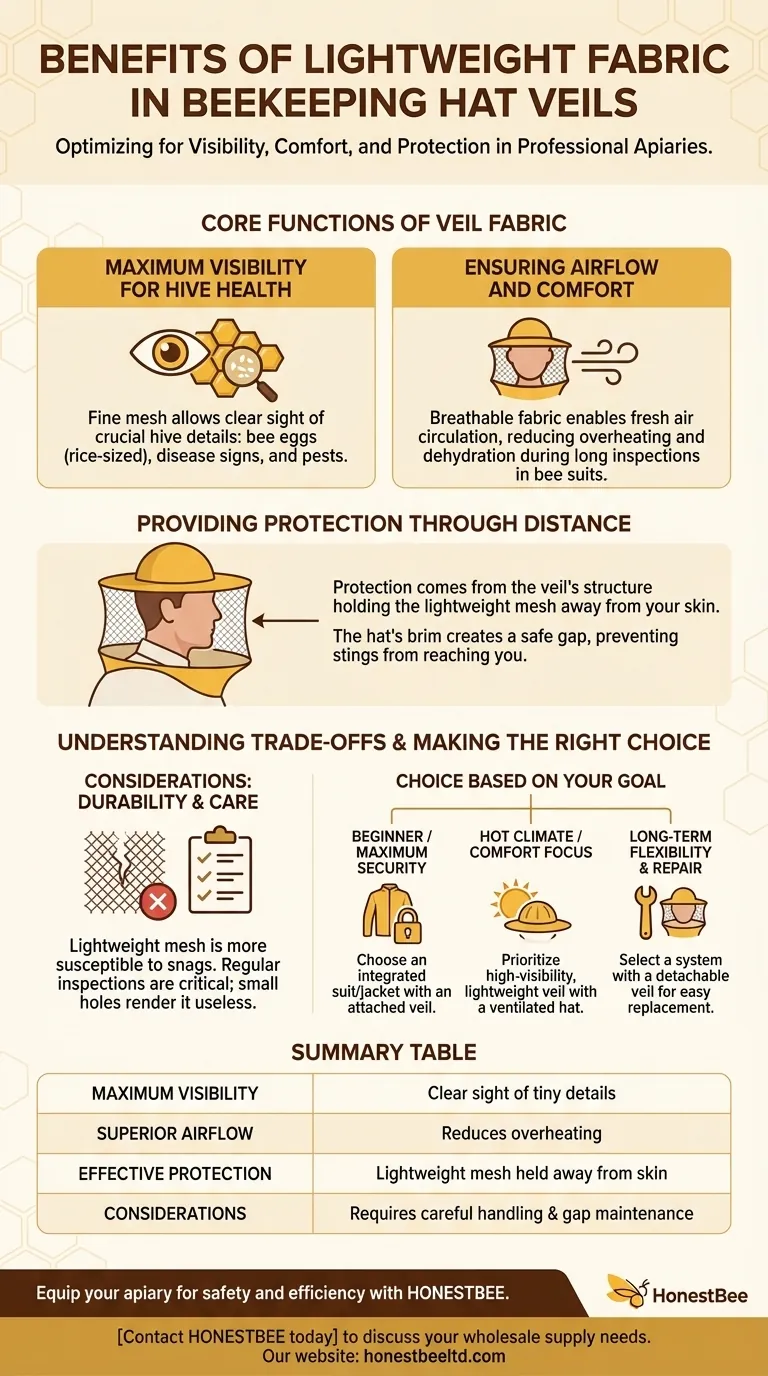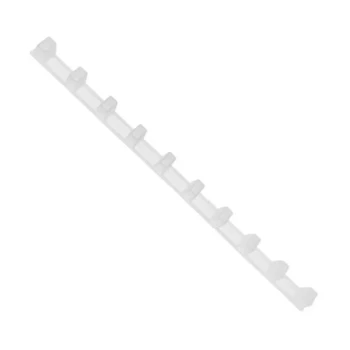At its core, the lightweight fabric used in a beekeeping hat veil is engineered to solve two fundamental challenges for the beekeeper: maintaining clear visibility and ensuring adequate airflow. This design directly impacts your ability to work safely and comfortably, allowing you to inspect hives effectively without overheating or having your view obstructed.
The choice of a lightweight veil is not a minor detail; it is a critical decision that balances the absolute need for protection against the practical demands of visibility and comfort required for careful, focused work within an active beehive.

The Core Functions of Veil Fabric
A beekeeper's veil is your primary interface with the hive. Its design must prioritize function without compromising the essential barrier against stings. The lightweight fabric is a direct result of optimizing for these functions.
Maximizing Visibility for Hive Health
The most cited benefit is maximum visibility. The fine, often black, mesh is designed to be minimally intrusive to your field of vision.
This is not just for convenience. Effective beekeeping requires you to spot tiny details, such as bee eggs (which are the size of a grain of rice), signs of disease, or the presence of pests. A clear view is essential for assessing hive health.
Ensuring Airflow and Comfort
Working in a full bee suit, often in direct sunlight on warm days, generates significant heat. The breathability of the lightweight fabric is a crucial safety and comfort feature.
It allows fresh air to circulate, reducing the risk of overheating and dehydration. This enables you to remain calm and focused for longer periods, which is critical when handling tens of thousands of stinging insects.
Providing Protection Through Distance
The protection from a veil doesn't come from the fabric being "sting-proof." It comes from the veil's structure holding the lightweight mesh away from your skin.
A bee's stinger is not long enough to bridge the gap created by the hat's brim. The lightweight nature of the fabric makes the entire hat assembly more comfortable to wear, ensuring you keep it on properly without fatigue.
Understanding the Trade-offs
While highly beneficial, lightweight veils are not without their considerations. Understanding the compromises is key to choosing and maintaining your equipment properly.
Durability and Care
A lighter mesh fabric can be more susceptible to snags and tears than heavier materials. A small hole in a veil renders it useless, as bees will quickly find the opening.
Regular inspection of your veil for any damage is a critical pre-inspection safety check.
Attached vs. Detachable Veils
Veils come either permanently attached to a hat or jacket, or as a detachable component.
Attached veils offer a more secure, bee-proof seal, which is often recommended for beginners. Detachable veils offer the flexibility to replace just the veil if it gets damaged, which is a common point of failure.
The Myth of Impenetrable Fabric
Never assume the mesh itself will stop a sting. If the veil is pressed against your neck or face—by wind or by turning your head inside a jacket—a bee can and will sting through the mesh. The protective gap is the most important element.
Making the Right Choice for Your Goal
Your choice in a veil system should align with your experience level and primary concerns.
- If your primary focus is maximum security as a beginner: Choose an integrated suit or jacket with an attached veil to minimize any chance of bees finding a gap.
- If your primary focus is comfort in a hot climate: Prioritize a high-visibility, lightweight veil and consider a separate, ventilated hat to maximize airflow.
- If your primary focus is long-term flexibility and repair: A system with a detachable veil allows you to easily replace the most fragile component without buying a whole new hat or suit.
Ultimately, the right veil empowers you to work with confidence, transforming a necessary piece of protective equipment into a tool for better beekeeping.
Summary Table:
| Benefit | Key Advantage |
|---|---|
| Maximum Visibility | Fine, often black mesh allows clear sight of tiny details like bee eggs and pests. |
| Superior Airflow | Breathable fabric reduces overheating, enabling longer, more focused hive inspections. |
| Effective Protection | Lightweight mesh is held away from skin by the hat's brim, creating a safe sting barrier. |
| Considerations | Requires careful handling to avoid snags; protection relies on maintaining a gap from skin. |
Equip your apiary for safety and efficiency with HONESTBEE.
Our wholesale-focused operations supply commercial apiaries and beekeeping equipment distributors with high-quality, durable protective gear designed for the demands of professional beekeeping. The right equipment, like a veil with optimal visibility and airflow, is crucial for productivity and safety.
Contact HONESTBEE today to discuss your wholesale supply needs and discover how our beekeeping supplies and equipment can support your business's success.
Visual Guide

Related Products
- Heavy Duty Cowboy Beekeeper Hat with Visibility Veil Outdoor Professional Beekeeping Protective Gear
- Beekeeper Cowboy Hat and Veil for Beekeeping
- Square Folding Bee Hat Veil with String for Beekeeping
- Cotton Beekeeping Suit and Round Hat with Veil Bee Keeper Protective Gear
- Professional Beekeeping Suit for Kids and Girls Childrens Bee Keeper Suit
People Also Ask
- How can beekeeping supplies and accessories enhance the hobby? Essential Tools for Safe & Rewarding Beekeeping
- What is the purpose of a hat and veil in beekeeping? Essential Protection for Head & Face
- Why are a hat and veil considered the most important parts of beekeeping protective gear? Essential Protection for Your Face and Confidence
- Why is head protection important for beekeepers? Essential Safety for Confident Hive Management
- What is the purpose of the high visibility veil on the beekeeping hat? Ensure Maximum Safety and Clarity



















